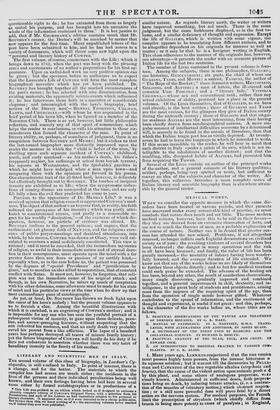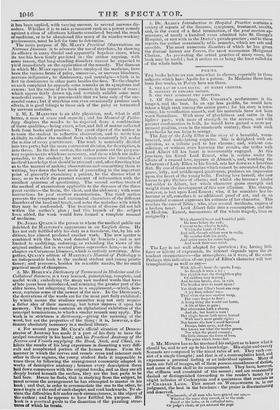MEDIC AL WORES.
WHEN we consider the opposite manner in which the same dis- orders have been treated at various periods, and that patients have recovered under every conceivable kind of practice, we must conclude that nature does much and art little. The more modern medical notions, however, have this to be said in their favour— they they are derived from an extensive observation of facts, and are not so much the theories of men, as a probable explanation of the course of nature. Neither can it be denied that greater suc- cess has attended the new school. Pestilence, if not altogether removed, no longer inflicts such frightful devastations on civilized society as of yore ; the revolting virulence of several disorders has been destroyed; the danger in many operations and the risk in all have been lessened; and finally, the value of life has been greatly increased,— the mortality of infancy having been wonder- fully lowered, and the average duration of life extended. We know not that any of the works before us are likely of themselves to further these objects directly; and to but few medical treatises could such praise be extended. The advance of the healing art has been, beyond any other, the result of numberless observations, many single discoveries, gradually improved and combined together, and a general improvement in skill, dexterity, and in- telligence, in the great body of students and practitioners, arising more from the impress of the inquiring spirit of the age, than from the operation of single minds however gifted. Whatever contributes to the spread of information, and the excitement of thought and experiment, is useful if not great : and this, perhaps, is the character of the five works before us, whose titles are as follows.
1. PRACTICAL OBSERVATIONS ON THE NATURE AND TREATMENT OF NERVOUS DISEASES. BY G. R. MART.
2. MANUAL OF PATHOLOGY. BY L. MARTINET, D.M.P. TRANS- LATED, WITH ALTERATIONS AND ADDITIONS, BY JONES QUAIN.
3. A DICTIONARY OF TIIE TERMS USED IN MEDICINE AND THE COLLATERAL SCIENCES. BY RICHARD D. IIOBLYN.
4. PRACTICAL ANATOMY OF THE HEAD, NECK, AND CHEST. BY EDWARD COCK, 5. AN INTRODUCTION TO HOSPITAL PRACTICE IN VARIOUS COM- PLAINTS. BY C. R. ALDIS.
I. Many years ago, LINN_EUS conjectured that the nux vomica must possess highly tonic powers, from the intense bitterness o its aqueous solution; but it was not till the discoveries by PELLE- TIER and CAYENTOU of the two vegetable alkalies (strychnia and brucia), that the cause of the violent action upon animals pro& e d by this plant, and some others of analogous properties, wars clearly known. Administered in sufficient doses, both prepara- tions bring on death, by inducing tetanic attacks, e. a contrac- tion of the muscles of voluntary motion,) which obstruct resin's- tion ; or a still more powerful dose will prove fatal by a direct action on the nervous system. For medical purposes, the French limit the prescription of strychnia (which chiefly differs from brucia in being more potent) to eases of paralysis ; in England, it has been applied, with varying success, to several nervous dis- orders. Whether it is to take permanent rank as a potent remedy against a class of affections hitherto considered beyond the reach eirnedicine, or to be abandoned like many of its wonder-working predecessors, must be left for time to determine.
The main purpose of Mr. MART'S Practical Observations on Nervous Diseases is to advocate the use of strychine, by showing its efficacy in many direful and apparently hopeless cases, when its use has been firmly persisted in ; the author arguing, with some reason, that long-standing disorders cannot be expected to yield immediately on the application of the remedy. The diseases in which Mr. MART appears to have employed the medicine, have been the various forms of palsy, amaurosis, or nervous blindness, nervous indigestior, tic douloureux, and neuralgia—which is in fact tic douloureux in other parts besides the face. To the chapter on each complaint he appends some remarks on its symptoms and causes: but the value of his book consists in his reports of cases ; which appear fairly drawn up, and certainly exhibit some most wonderful cures. It is presumeable that we hear only of the suc- cessful cases ; but if strychine can even occasionally produce such effects, it is good tidings to those sick of the palsy or tormented by nervous maladies.
2. M. L. MARTINET is an able physician, and, what is still better, a man of sense and sagacity ; and his Manual of Patho- logy displays the results to be expected from a combination of these qualities,—being exact, sober, and full of matter collected both horn books and practice. The great object of the author is to train the student to reflective observation, and to incite him skilfully to collect the medical facts which constantly fall under the notice of every practitioner. The work is nominally divided into two parts; but the more convenient division, for description, is into three. In the first section, the author points out the preeam- tory acquirements which are necessary, and those which are indis- pensable, to the student; he next enumerates the branches of medical knowledge that should be attained ; and, after directing, him as to the manner of making observations and committing them to writing, lays down the best mode of proceeding in the important point of generally examining a patient, be the disease what it may, so as to elicit the greatest amount of information with the smallest quantum of questioning. The second section treats of the method of examination applicable to the diseases of the three great cavities—the brain, the chest, and the abdomen; with some instructions for post mortem examinations. The third section presents the symptoms and anatomical characters of the different disorders of the head and trunk, and notes the maladies with which they may be confounded. The treatment of disease did not fall within the author's plan ; had this branch of the subject been added, the work would have formed a complete manual of medicine.
Dr. JONES QUAIN is the person to whom the medical public are indebted for MARTINET'S appearance in an English dress. He has not only fulfilled ably his duty as a translator, but, by his ad- ditions, has almost produced another work. The new matter is combined with the text, and denoted by brackets ; and is not limited to modifying, enforcing, or extending the views of the original author, but in several places supersedes hitn,—as in the chapter on Cutaneous Diseases, which is entitely rewritten. Alto- gether, QUAIN'S edition of MARTINET'S Manual of Pathology is an indispensable book to the medical student and young practi- tioner; and possesses, besides its scientific merits, the no small practical merit of cheapness.
3. Mr. HOHLY et's Dictionary of Terms used in Medicine and the Collateral Sciences, is a very learned, painstaking, complete, and useful work; embodying the many new medical words that have of late years been introduced, and retaining the greater part of the older terms, but relegating them to a supplement,—which, how- ever, contains some of the newest of the new. In the Dictionary, the derivations of the words are for the most part fully exhibited; by which means the studious consulter may not only acquire a fuller idea of their meaning, but better impress it upon his memory. The preface contains an alphabetical exhibition of the principal terminations, to which a similar remark may apply. The • work is in strictness a dictionary,—giving the meaning of the word, but not the properties of the thing : it is, however, a dic- tionary absolutely necessary in a medical library.
4. For several years Mr. COCK'S official situation of Demon- strator of Anatomy has made it a part of his duty to have the scalpel constantly in his hand; and his Practical Anatomy of the Nerves and Vessels supplying the Head, Neck, and Chest, ex- hibits the results of his long experience in dissecting a very diffi- cult and complicated portion of the human frame. From the manner in which the nerves and vessels cross and intersect each other in those regions, the young student finds it impossible to trace them by following the arrangement necessarily adopted in works of descriptive anatomy ; because every description there laid down commences with the original trunks, and as they are all deeply buried beneath the surface, they are the last parts to be laid bare. Hence he finds, that in studying from the subject, he must reverse the arrangement he has attempted to master in his book ; and that, in order to accommodate the one to the other, he must begin at the end of each chapter, and read backwards. To ob- viate the difficulties felt under such circumstances, is the object of the author ; and he appears to have fulfilled his purpose. His book is a practical guide to the dissection of the puzzling struc- tures of which he treats. 5. Dr. ALOIS'S Introduction to Hospital Practice contains a variety of reports of the diseases, symptoms, treatment, results, and, in the event of a fatal termination, of the post mortem ap- pearance, of nearly a hundred cases admitted into St. George's Hospital, or met with in the Doctor's private practice ; and to these reports the author occasionally adds remarks, which are safe and sensible. The most numerous disorders of which he has given the diurnal history are Fevers, the most uncommon Malignant Cholera. As presenting the actual practice of many cases, the book may be useful ; but it strikes us as being the least called-for of the whole batch.



























 Previous page
Previous page